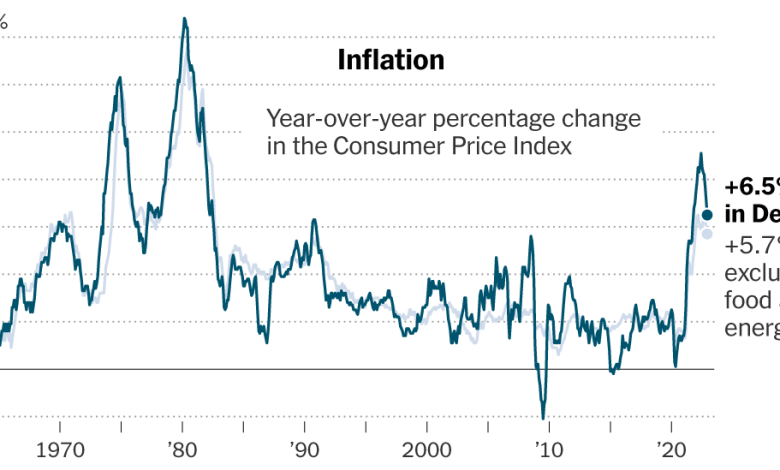Inflation Is Slowing, Good News for American Consumers and the Fed

Inflation slowed on an annual basis for a sixth straight month in December, a relief for households and an encouraging signal for the Federal Reserve and the White House that the worst of America’s pandemic-induced inflation burst may be in the past.
The Consumer Price Index climbed 6.5 percent in the year through last month, down from 7.1 percent in the November reading, as prices declined on a monthly basis for the first time in more than two years. The annual inflation rate was the slowest since October 2021, a pullback driven by falling gas prices and cheaper airfares.
Economists and Fed officials are more acutely focused on a so-called core inflation measure, which removes food and fuel prices to get a sense of underlying price trends. That measure ticked up on a monthly basis, but the yearly measure slowed to 5.7 percent in December from 6 percent previously.
Altogether, the data provided the latest evidence that inflation is moderating meaningfully, bringing consumers relief as they try to purchase a used vehicle, take a road trip or buy new furniture. But price increases are still unusually fast across a number of goods and services, from food to car maintenance, and the key question now is how quickly and completely inflation will return to prepandemic levels of around 2 percent after a year and a half of rapid increases.
President Biden greeted the report enthusiastically, emphasizing the role that his policies — including efforts to lower the cost of gas — have played in helping prices to climb more slowly. In remarks from the White House on Thursday, Mr. Biden said that moderating inflation “adds up to a real break for consumers, real breathing room for families and more proof that my economic plan is working.”

The annual inflation rate was the slowest since October 2021, a pullback driven by falling gas prices.
Credit…Hiroko Masuike/The New York Times
For the Fed, the report confirms that the slowdown in price gains that officials have long expected is finally coming to fruition. That could help policymakers, who have begun slowing the pace of interest rate increases, feel comfortable moving even more incrementally.
Inflation F.A.Q.
What is inflation? Inflation is a loss of purchasing power over time, meaning your dollar will not go as far tomorrow as it did today. It is typically expressed as the annual change in prices for everyday goods and services such as food, furniture, apparel, transportation and toys.
What causes inflation? It can be the result of rising consumer demand. But inflation can also rise and fall based on developments that have little to do with economic conditions, such as limited oil production and supply chain problems.
Is inflation bad? It depends on the circumstances. Fast price increases spell trouble, but moderate price gains can lead to higher wages and job growth.
How does inflation affect the poor? Inflation can be especially hard to shoulder for poor households because they spend a bigger chunk of their budgets on necessities like food, housing and gas.
Can inflation affect the stock market? Rapid inflation typically spells trouble for stocks. Financial assets in general have historically fared badly during inflation booms, while tangible assets like houses have held their value better.
Fed officials adjusted their policy at the fastest pace in decades last year to try to wrangle rapid inflation, but with rates at a higher level and inflation showing early signs of slowing, they shifted to a half-point adjustment in December following a string of three-quarter point rate moves. Now, policymakers have made it clear that they are contemplating an even more modest quarter-point change in February.
The fresh inflation data probably bolsters the case for that gentler path, which will give officials more time to see how their policies are playing out in the economy and how much more is needed.
“I expect that we will raise rates a few more times this year, though, to my mind, the days of us raising them 75 basis points at a time have surely passed,” Patrick Harker, the president of the Federal Reserve Bank of Philadelphia, said in a speech on Thursday. “In my view, hikes of 25 basis points will be appropriate going forward.”
Yet the new report did little to suggest that the problem of rapid price increases has been entirely solved, which is why central bankers are still expected to push borrowing costs at least slightly higher and leave them elevated for some time to wrestle price increases under control.
“This report really supports a downshift,” said Blerina Uruci, chief U.S. economist in the fixed income division at T. Rowe Price. “But I don’t think this changes the overall inflation picture: We’re making progress on decelerating inflation, but from a very high level.”
Several trends should help to slow price increases this year. More muted cost changes for goods are expected to help cool overall inflation as supply chains heal. Used cars and trucks, a big driver of inflation in 2021 and early 2022, became cheaper last month, for instance. New cars also declined slightly in price.
Housing costs should also moderate later this year. Climbing rents bolstered inflation in December and could continue to push inflation higher for a while, but that is expected to reverse with time. Rents for newly leased apartments have begun to climb much more slowly, private data suggests, which will gradually feed into the government’s official inflation measure.
But there are still lingering risks. Most notably, economic officials are closely watching what is happening with prices for other services, which include things like hotel rooms, sporting event tickets and health care. They worry that services inflation — which is unusually rapid — could keep prices increasing faster than the central bank’s target. The Fed aims for 2 percent inflation on average, using a price measure that is different from but related to the Consumer Price Index.
Core services prices excluding housing costs, a measure that both the Fed and economists are watching closely, picked up 0.3 percent in December on a monthly basis. That was up from 0.1 percent in November, according to calculations by Omair Sharif, founder of Inflation Insights.
Understand Inflation and How It Affects You
- Federal Reserve: Federal Reserve officials kicked off 2023 by grappling with a thorny question: How should central bankers understand inflation after 18 months of repeatedly misjudging it?
- Social Security: The cost-of-living adjustment, which helps the benefit keep pace with inflation, is set for 8.7 percent in 2023. Here is what that means.
- Tax Rates: The I.R.S. has made inflation adjustments for 2023, which could push many people into a lower tax bracket and reduce tax bills.
- Your Paycheck: Inflation is taking a bigger and bigger bite out of your wallet. Now, it’s going to affect the size of your paycheck in 2023.
“What we’ve done is made a pivot from goods inflation,” Mr. Harker said in a question-and-answer session following his speech. “Service inflation ex-shelter is still running really high.”
Many central bankers think that to get services inflation under control, they need to slow down the job market and tamp down wage gains. Otherwise, companies facing larger labor bills are likely to continue passing those costs along to consumers.
“The biggest cost, by far, in that sector is labor,” Jerome H. Powell, the Fed chair, said at his latest news conference in December. “And we do see a very, very strong labor market, one where we haven’t seen much softening, where job growth is very high, where wages are very high.”
That is why central bankers have remained resolute, if more measured, when it comes to raising interest rates. Higher borrowing costs can discourage consumers from making big purchases, like cars and houses, while slowing business expansions and eventually tamping down hiring and pay gains.
Investors do expect the Fed to raise rates slightly more, but not by as much as officials are predicting. Markets are betting that policymakers will announce a quarter-point move at their Feb. 1 meeting, taking the main policy rate to 4.5 to 4.75 percent, but investors expect rates to remain below the 5.1 percent peak that Fed officials have predicted.
“There is profound skepticism now,” said Ian Shepherdson, chief economist at Pantheon Economics, who thinks that the central bank has done enough at this point to put inflation on a path back to normal. “I’m not sure that there are many people in markets who believe that they are going to go hike, after hike, after hike.”
A major question is whether inflation will be able to slow without sending the economy into a painful downturn. As price increases moderate, many on Wall Street and some within the central bank have expressed hope that a soft landing, in which inflation moderates without serious economic pain, might be possible.
“I remain what I call a realistic optimist,” Susan Collins, president of the Federal Reserve Bank of Boston, said in an interview on Wednesday. “There is resilience that I continue to see in the economy, and that makes me optimistic that there is a path to reducing inflation without a significant downturn.”




